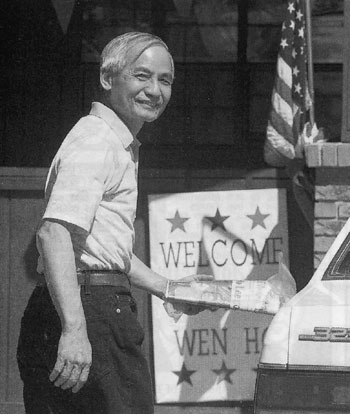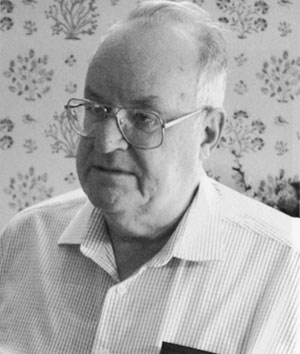
This Article From Issue
July-August 2002
Volume 90, Number 4
DOI: 10.1511/2002.27.0
A Convenient Spy: Wen Ho Lee and the Politics of Nuclear Espionage. Dan Stober and Ian Hoffman. 334 pp. Simon & Schuster, 2001. $26.
My Country Versus Me: The First-Hand Account by the Los Alamos Scientist Who Was Falsely Accused of Being a Spy. Wen Ho Lee with Helen Zia. xiv + 332 pp. Hyperion, 2001. $23.95.
These two books cover the story of the suspicions that led to the arrest in 1999 of Wen Ho Lee, a computer scientist at the Los Alamos National Laboratory. Lee was indicted on charges of abusing classified material with "intent to injure the United States"—a phrase that most people interpreted as shorthand for espionage. After 277 days of incarceration, he struck a bargain with prosecutors in which he pled guilty to only one count (out of 59) of misuse of classified materials and was sentenced to time served and released on the condition that he would be available for questioning for the next year. This plea bargain was widely and correctly interpreted to be a defeat for the government, whose case against Lee had fallen apart for lack of any evidence of espionage.

From A Convenient Spy.
In A Convenient Spy, Dan Stober and Ian Hoffman offer an excellent sequential account of this complex series of events. They also cover facets of China's nuclear weapons program, emphasizing in particular that the Chinese have been much more forthcoming than they are given credit for. Their book describes the many visits American scientists have made to Chinese nuclear weapons sites (something Lee also mentions in his own book).
In My Country Versus Me, an "as told to" story written by Helen Zia, Wen Ho Lee describes his history and lifestyle. Proffering self-serving explanations of his conduct, he strives greatly (but with only limited success) to justify his mishandling of classified information. He intends to appeal to the reader's emotions, and he describes actual events out of order, with flashbacks. His account emphasizes the anti-Chinese racial bias of many of the government investigators.

From A Convenient Spy.
In both books, Lee comes across as very competent in his work designing the software used to describe the hydrodynamics inherent in nuclear explosions, although his expertise is quite narrow. These accounts characterize him as a somewhat insecure individual and suggest that his insecurity translated into eager cooperation with all parties—foreign scientists and other visitors, as well as the FBI and other inquisitors. Only after the investigation of him was relatively far advanced did he accept legal representation. The books also have in common that they portray many of the participants in this drama—the FBI, several officers of the Department of Energy (including the Secretary), high officials in the Department of Justice and members of the Congressional committees investigating Chinese espionage—as inept, and some as thoroughly bad actors. Only a few individuals behaved admirably, including Harold Agnew, former Director of the Los Alamos National Laboratory; John Richter, one of the key weapons designers at Los Alamos; and Robert S. Vrooman, former CIA liaison to the laboratory at Los Alamos. All three put Lee's codes in perspective as being of relatively minor value to foreign parties. In contrast, the senior laboratory officers who bore witness against Lee appear to have been willing to stretch the truth in order to make a political point; in misleading testimony they described the mishandled codes as "crown jewels" and as "upsetting the strategic balance."
Lee walks a tightrope in his book: On the one hand, he wants to puff up his contributions to the national security of the United States by emphasizing the importance of his work. On the other, he wants to downplay the military significance of the possibility that his work fell into unfriendly hands. His final explanation of why he committed the felony to which he ultimately pled guilty is not very convincing. He downloaded a very large amount of nuclear weapons code—information classified as "Protect as Restricted Data" (but not yet as "Confidential" or "Secret")—from the secure to the unsecure computer network at Los Alamos and made tapes of some of this information; some of the tapes were lost, and he said he had destroyed them. He explains his conduct by saying that he wanted to have back-up information in case of changes in the computer operating system or in case the computer crashed, but he does not satisfactorily explain why he was not able to provide for that backup within the secure system to which he had access.
The government pursued the case initially under the assumption that Lee had acted on behalf of either China or possibly Taiwan, but this supposition turned out to be unsupported by the evidence. The case completely collapsed when the government tried to promote the hypothesis that Lee transcribed the information to support potential job applications in foreign countries, including—of all places—Switzerland. Subsequently a key FBI witness, Robert Messemer, turned out to have given misleading and even totally incorrect testimony, which he had to retract. Notra Trulock, former counterintelligence chief of the Department of Energy, told many parties in Congress and the executive branch that Lee's behavior was consistent only with espionage by China. But the actual formal investigation had resulted only in vague conclusions, as Trulock was well aware.
The response of the political authorities can only be described as ugly. The Cox Committee was originally chartered by the Republican leadership in the House of Representatives to examine the allegation that the Clinton administration had been influenced by political contributions from China; unable to prove that, the committee shifted its focus to Chinese nuclear espionage. The report of the committee contained exaggerations and many factual errors, and was generally unsupported by evidence.
The key piece of evidence that did support the committee's case was a document that had been delivered to the CIA in Taiwan by a "walk-in" Chinese agent, which described classified information regarding several American nuclear warheads. The committee, and also Trulock, maintained that this warhead information probably originated from Los Alamos. But in fact the technical nature of the document was such that it was more likely to have been diverted from the Defense Department or its contractors, because it gave information about the external properties of the warheads rather than their internal design.
Initially, the Cox Committee report was highly classified, and for several months the committee's staff debated with the Clinton administration over what could be made public. During that period the New York Times printed a series of selected leaks from the committee's findings; these and a subsequent media "spy frenzy" resulted in enormous political pressure to produce a culprit. One Times article particularly damaging to Wen Ho Lee was based on information provided by the Secretary of Energy. More than a dozen Congressional hearings were held.
The picture that emerges is that political concerns and influences seem to have superseded an unbiased professional investigation of the facts by government prosecutors and New York Times journalists. This story is chronicled admirably and in depth by Stober and Hoffman, reporters for the San Jose Mercury News and the Albuquerque Journal respectively. Their excellent, sober and factual account is well worth reading for the light it sheds on murky events.
Wen Ho Lee's book, in contrast, does not convey a good understanding of all the circumstances but is interesting nonetheless for its illumination of Lee's personality and character.
Both books document the wide public interest the case generated. Lee's book cites extensively the activities, orchestrated in part by his daughter, of Chinese-American groups, quoting from their statements in repetitious detail. Both books cite the objections of professional scientific societies to denial of bail for Lee and to the harsh conditions of his incarceration, noting that the societies did not take a stand on Lee's guilt or innocence.
At the end of the case, Judge James A. Parker, who presided over the final trial, apologized to Lee eloquently for having been "led astray by the executive branch of our government." No apologies were ever made by the White House, Congress or the press. The books constitute a depressing record of both official and media misconduct.
The precise motive for Lee's transgression is not elucidated in either volume. Perhaps the best explanation, consistent with both accounts, can be found in the advice John Richter gave when he testified before Judge Parker: "Never attribute to malice what can be adequately explained by stupidity."
American Scientist Comments and Discussion
To discuss our articles or comment on them, please share them and tag American Scientist on social media platforms. Here are links to our profiles on Twitter, Facebook, and LinkedIn.
If we re-share your post, we will moderate comments/discussion following our comments policy.